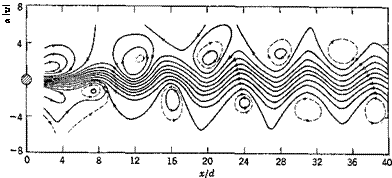SOME TYPICAL EXAMPLES OF AEROELASTIC OSCILLATIONS

Whoever has rowed a boat must have observed the trail of vortices leaving the oar. One can easily perform an experiment by moving a stick in water with sufficient speed and observe the wake. In the wake the flow is turbulent, but a vortex pattern can be seen (Fig. 2.1). These vortices are “shed” alternately from each side of the stick. This shedding of vortices induces a periodic force in the direction perpendicular to the line of motion, and the stick wobbles back and forth. Similar action occurs on any cylindrical body with a blunt nose or tail. The frequency
of the wake vortices is determined by the geometry of the body and the speed of flow. If the frequency is close to the natural vibration frequency of the body, resonance will set in.
Among examples of engineering significance, the most familiar is probably the oscillation of telephone wires,2’7 with high frequency and small amplitude, producing musical tones. Smokestacks,2’3 submarine periscopes,21 oil pipe lines,2 2 television antennas,21 and other cylindrical structures2-7 often encounter vibrational troubles of aeroelastic origin. These may be cured either by stiffening the structures so that the natural frequency is much higher than the frequency of the vortex shedding in
wind or by introducing vibration dampers into the system to absorb the energy.[6]
A different type of vibration is the “galloping” of transmission lines.2-4-2-5 During a sleet storm a transmission line may vibrate in a strong wind. The cable span oscillates sometimes as a whole, but more frequently with one or more nodes in a span. When the oscillations become severe, the cables move irregularly, but freely, through vertical distances of as much as 20 to 35 ft in a span of 500 ft. The phenomenon cannot be observed every day, nor can it be seen at any specific place; it appears and disappears suddenly. Once started, it is very persistent. Sometimes it may continue for 24 hours. The cause of galloping has been shown to be the sleet on the conductors. The ice forms a cross section of a more or less elliptical shape, with the major axis perpendicular to the wind direction. Such a section is unstable in an airstream: the aerodynamic force exerts a “negative damping" component so that, once the oscillation is started, it will continue to build up. – The observed frequencies of oscillation are close to the natural frequencies of the span. The vibration will stop when the ice is broken and thrown off the line.
Since vibrations of this type are originated from unfavorable aerodynamic configurations, they can be avoided by preventing such unfavorable configurations from occurring. For transmission lines, however, a satisfactory solution has not yeFfieen found.
The two types of aeroelastic oscillations considered above are characterized by a separated flow in the rear of the body, i. e., a flow that does not follow the contour of the solid body. Let us now consider another type of self-excited oscillation which does not necessarily involve flow separation. This is the flutter. The best example occurs in the field of aeronautics where streamlining is a rule and flow separation is avoided. In civil engineering, suspension bridges sometimes have sufficiently clean contours so that the flow may be considered as essentially unseparated; but, as a rule, separation does occur over part of the body or during part of the oscillation cycle; hence the name stall flutter. The failure of the original Tacoma Narrows Bridge210 is generally believed to be due to stall flutter. This bridge was a suspension structure, with a center span of 2800 ft, two side spans of 1100 ft each, and a width of 39 ft center to center of cables. The cables had a sag ratio of 1/12. The stiffening structure was of the plate-girder type. Vertical oscillations of considerable amplitudes were first observed during the erection of the suspended

|

|

floor and continued, at intervals, until the day of failure, but no damage was done. On November 7, 1940, four months after the bridge was opened to traffic, suddenly at a wind speed of 42 mph, the center span developed a torsional movement with a node at mid-span. (There was, however, considerable motion at the mid-point.) The frequency of oscillation suddenly changed from 37 to 14 cycles per minute. The motion grew violently, and failure occurred half an hour later.
A lesson learned from the Tacoma Bridge is the recognition of the importance of aeroelastic investigations in structural design. The conventional design procedure focuses mostly on the strength of a structure, whereas the aeroelastic design focuses on the rigidity, damping characteristics, and the aerodynamic shape. Hence there exists a different point of view.
The three types of oscillations illustrated above can occur in a uniform flow without external disturbance. For that reason they are often said to be self-excited.











